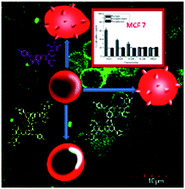Investigations on the membrane interactions of naringin and its complexes with copper and iron: implications for their cytotoxicity
Abstract
Flavonoid glycosides are a group of polyphenols with different glycoside substituents that possess diverse pharmacological activities albeit with lesser potency than their aglycone counterparts. Complexation with transition metal ions may alter their pharmacological activity, but this facet has remained unexplored thus far. Therefore, the present study aims to synthesize copper and iron complexes of naringin and investigate their nature of membrane interactions employing erythrocyte membrane models. An attempt to correlate their interaction and localization in the membrane with their cytotoxic effects was also made. Hypotonic hemolysis experiments carried out in the presence of naringin or its complexes with copper or iron reveals their different extent of penetration in to the membrane. Naringin and naringin–iron were found to preferentially interact with the membrane surface when compared with naringin–copper. The transformation of erythrocyte membrane from the normal discoidal shape to an echinocyte form induced by the addition of naringin, naringin–copper and naringin–iron complex suggests their interaction with the outer leaflet of the erythrocyte membrane. Naringin–copper exhibited the maximum tendency to alter the morphology of erythrocyte membranes. The copper and iron complexes of naringin exhibit superior cytotoxicity against MCF-7 cancer cells that can be a manifestation of their degree of perturbation of the membrane architecture as well as different levels of activation of various molecular targets.


 Please wait while we load your content...
Please wait while we load your content...